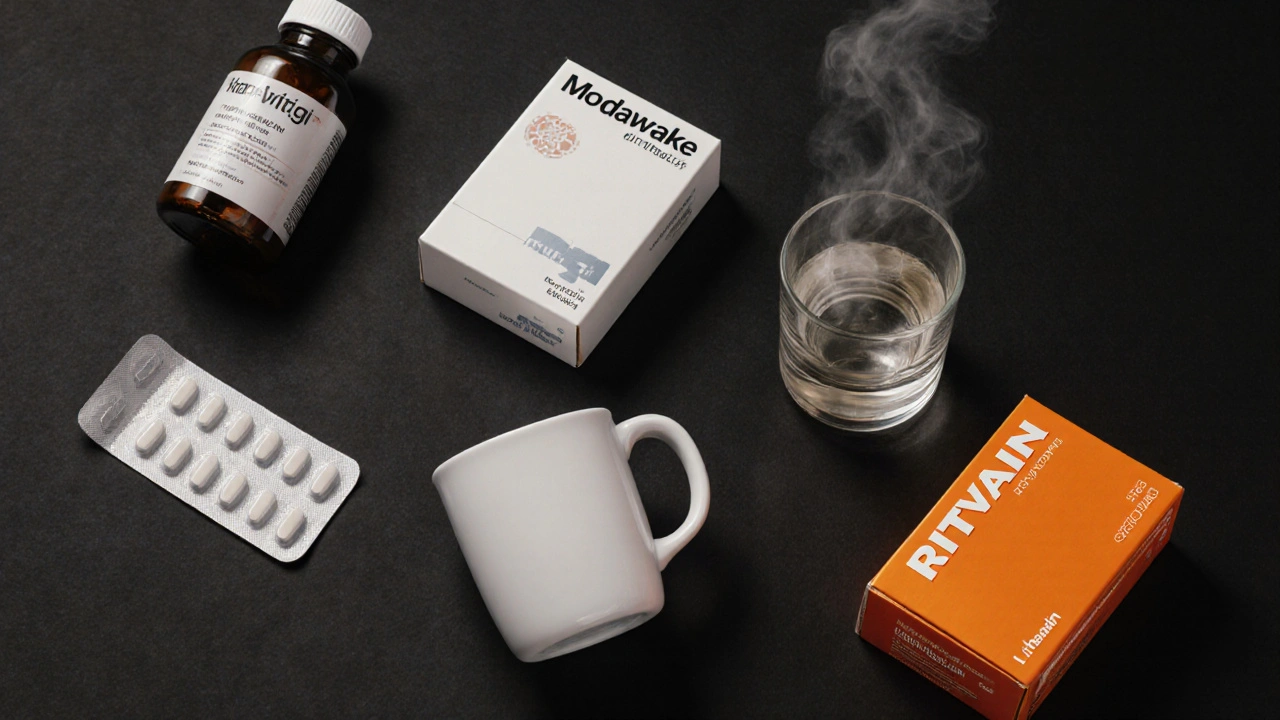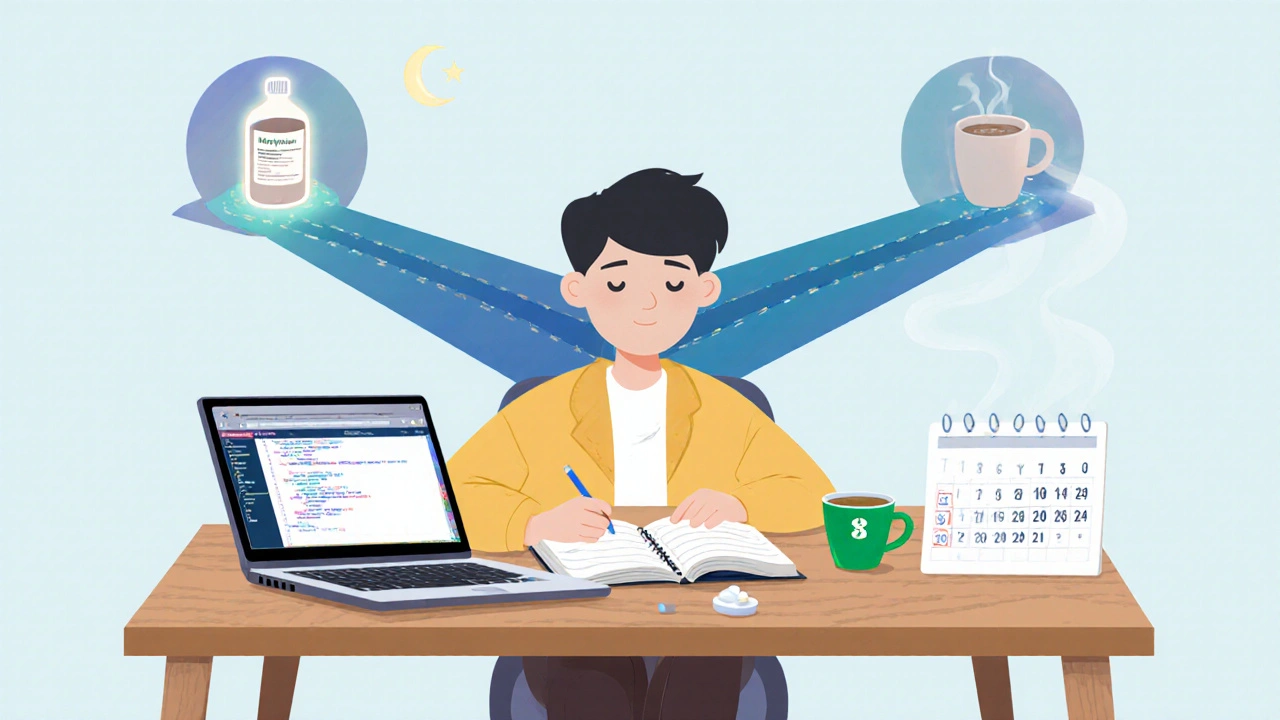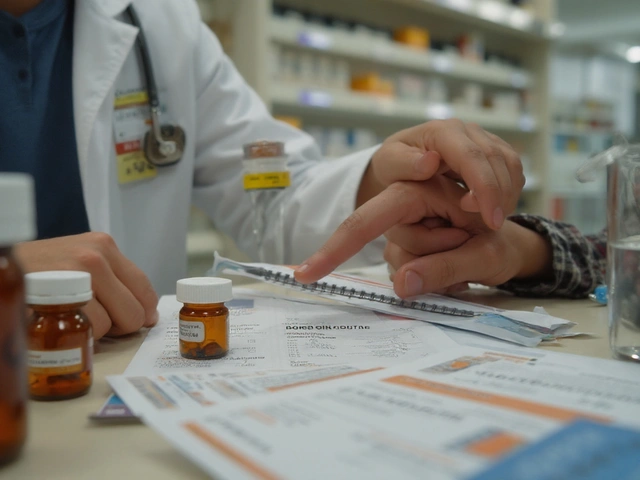Modawake vs Alternatives Decision Tool
| Brand | Generic Name | Prescription? | Duration | Side Effects | Monthly Cost | Match |
|---|
Quick Takeaways
- The Modawake brand delivers the same active ingredient as generic modafinil but often at a higher price.
- Provigil and Nuvigil are FDA‑approved brand versions of modafinil and armodafinil with similar efficacy.
- Adrafinil is an over‑the‑counter pro‑drug that converts to modafinil in the liver, but it can stress the liver.
- Caffeine and L‑theanine provide mild alertness with far fewer side effects, suitable for occasional use.
- Prescription status, half‑life, and cost are the three most decisive factors when choosing a wake‑fulness aid.
Ever felt the slump after a night shift or while pulling an all‑night study session? You’re not alone. Many people turn to wake‑fulness agents to stay sharp, but the market is a mixed bag of prescription meds, over‑the‑counter supplements, and everyday stimulants. This guide breaks down Modawake-a brand of modafinil-against the most common alternatives, so you can decide what fits your schedule, budget, and health profile.
Modawake is a branded version of modafinil, a prescription medication that promotes wakefulness by influencing dopamine and orexin pathways in the brain. It’s marketed primarily for narcolepsy, shift‑work sleep disorder, and occasional off‑label cognitive enhancement. Because it’s a brand name, the price tag can be considerably higher than generic equivalents.
How Modawake Works
Modafinil, the active ingredient in Modawake, blocks the reuptake of dopamine, raising its extracellular levels. It also stimulates orexin‑producing neurons, which help keep the sleep‑wake cycle stable. The net effect is a smoother, non‑jittery alertness that lasts 12‑15hours, without the classic “high” associated with classic stimulants like amphetamines.

Key Criteria for Comparing Wake‑fulness Agents
When you line up Modawake against other options, focus on these four pillars:
- Prescription requirement: Determines legal accessibility and insurance coverage.
- Onset & duration: How quickly you feel alert and how long the effect lasts.
- Side‑effect profile: From mild headaches to liver concerns.
- Cost per month: Direct price, insurance impact, and any hidden fees.
Each alternative scores differently across these dimensions, as shown in the table below.
| Brand | Generic Name | Prescription? | Typical Dose | Onset | Half‑life | Common Side Effects | Approx. Monthly Cost (USD) |
|---|---|---|---|---|---|---|---|
| Modawake | Modafinil | Yes | 100‑200mg | 30‑60min | 12‑15h | Headache, nausea, insomnia | $150‑$200 |
| Provigil | Modafinil | Yes | 100‑200mg | 30‑60min | 12‑15h | Dry mouth, anxiety | $120‑$180 (insurance may lower) |
| Nuvigil | Armodafinil | Yes | 150‑250mg | 30‑60min | 15‑16h | Dizziness, rash | $130‑$190 |
| Adrafinil (OTC) | Adrafinil | No | 300‑600mg | 45‑90min | ≈12h (via conversion to modafinil) | Liver enzyme elevation | $30‑$50 |
| Caffeine + L‑Theanine | Caffeine / L‑Theanine | No | 100mg caffeine + 200mg L‑Theanine | 15‑30min | 4‑6h (caffeine) | Jitters, mild insomnia | $5‑$10 |
| Ritalin | Methylphenidate | Yes | 10‑20mg | 20‑30min | 2‑3h | Appetite loss, increased BP | $30‑$70 |
Deep Dive on Each Alternative
Provigil
Provigil is the original brand‑name version of modafinil, approved by the FDA in 1998. Its efficacy mirrors Modawake because the molecule is identical. The main differences lie in price (often slightly lower due to insurance contracts) and brand perception. Some users report a marginally smoother “come‑up” compared to generic versions, but scientific studies show no statistically significant gap.
Nuvigil
Nuvigil contains armodafinil, the R‑enantiomer of modafinil. This single‑isomer formulation tends to have a slightly longer half‑life, making it the go‑to for people who need alertness into the early morning hours. It’s also a bit pricier, and a few small trials suggest a modest reduction in evening “crash” symptoms.
Adrafinil
Adrafinil is sold as an over‑the‑counter supplement in many countries. Your liver converts it into modafinil, so the end result is similar. However, the conversion process taxes liver enzymes (CYP450), raising concerns for long‑term liver health. Blood tests every 3‑6months are advised for chronic users. The upside? No prescription needed, and the price is a fraction of brand‑name meds.
Caffeine + L‑Theanine
This combo is a favorite among students and knowledge workers. Caffeine blocks adenosine receptors, giving a quick boost, while L‑theanine (found in tea) smooths the jitteriness. The effect peaks within 30minutes and tapers off after 4‑6hours-ideal for short‑term focus without lingering insomnia. Side effects are minimal unless you exceed 400mg caffeine daily.
Ritalin
Methylphenidate (Ritalin) is a classic stimulant used for ADHD. It works by increasing dopamine and norepinephrine in the synaptic cleft. While it provides strong alertness, the shorter half‑life (2‑3hours) means you may need multiple doses for a full workday, raising the risk of side‑effects like appetite loss and blood‑pressure spikes. Prescription‑only and generally not first‑line for pure wake‑fulness needs.
Best‑Fit Scenarios
Not every option suits every lifestyle. Below is a quick guide based on common use‑cases.
- Shift workers needing 12‑hour coverage: Modawake, Provigil, or Nuvigil-pick the brand that fits your insurance. \n
- Students looking for a cheap, occasional boost: Caffeine + L‑Theanine or low‑dose Adrafinil (with liver monitoring).
- People with liver concerns: Stick to prescription modafinil (Modawake, Provigil) rather than Adrafinil.
- Budget‑conscious users: Generic modafinil or Adrafinil beats brand names; the caffeine combo is the cheapest.
- Those who want the longest night coverage: Nuvigil (armodafinil) because of its ~15‑hour half‑life.

Safety Tips & Common Pitfalls
Regardless of the product, keep these safety rules in mind:
- Never exceed the recommended dose. Doubling a 200mg modafinil dose does NOT double the alertness-it just raises side‑effect risk.
- Avoid late‑day dosing if you need to sleep soon. Even the longest‑acting agents can disrupt sleep if taken after 2PM.
- Stay hydrated. Modafinil and caffeine can both increase urine output.
- Watch for drug interactions. Anticonvulsants, hormonal contraceptives, and certain antibiotics can lower modafinil levels.
- Consult a healthcare professional before combining stimulants with SSRIs or MAO inhibitors.
Decision Checklist
Before you click ‘order’, run through this short list:
- Do you have a valid prescription or can you obtain one safely?
- Is the duration (12‑16hours) aligned with your work or study schedule?
- Are you okay with the potential side effects (headache, insomnia, liver impact)?
- What is your monthly budget for the product?
- Do you need a brand‑name for insurance coverage, or will a generic suffice?
If the answer to most questions leans “yes,” Modawake or its close relatives (Provigil, Nuvigil) are solid choices. If cost or prescription barriers are a deal‑breaker, consider Adrafinil for occasional use or the caffeine‑L‑theanine combo for daily micro‑boosts.
Frequently Asked Questions
Is Modawake the same as generic modafinil?
Yes. Modawake contains the same active ingredient-modafinil-as generic versions. The difference lies mainly in branding and price.
Can I buy Modawake without a prescription?
In the United States and most Western countries, Modawake is prescription‑only. Some online pharmacies claim otherwise, but purchasing without a doctor’s order carries legal and safety risks.
How does Adrafinil compare to Modawake in terms of effectiveness?
Adrafinil converts to modafinil after ingestion, so the end effect is similar. However, the conversion takes extra time (45‑90minutes) and puts extra load on the liver, making it less ideal for daily long‑term use.
Is the caffeine‑L‑theanine combo strong enough for night‑shift workers?
For most people, the combo offers a mild to moderate boost lasting 4‑6hours. It won’t match the 12‑hour coverage of modafinil, but it’s safe, cheap, and has virtually no severe side effects, making it a good supplemental option.
What are the most common side effects of Modawake?
Typical side effects include headache, nausea, dry mouth, and occasional insomnia. Rarely, users report anxiety or rash. Most side effects are dose‑dependent and subside after the first few days of use.






Written by Martha Elena
I'm a pharmaceutical research writer focused on drug safety and pharmacology. I support formulary and pharmacovigilance teams with literature reviews and real‑world evidence analyses. In my off-hours, I write evidence-based articles on medication use, disease management, and dietary supplements. My goal is to turn complex research into clear, practical insights for everyday readers.
All posts: Martha Elena